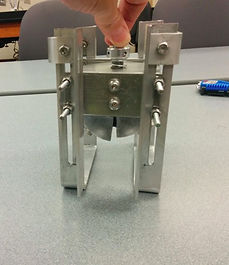Our Device - "Chip 'n' Ship"
Final Device
Here is the final version of the Chip 'n' Ship that was tested in the NBL! Before the engineering presentation, there was no color coding or screw caps on the chipping cartridges. The engineers and divers also had us add an extension to the pneumatic hammer air valve, to accomodate for larger hands and help prevent turning on the pneumatic hammer accidentally. Overall, we had a lot of positive feedback about our device!






Cartridge 3.0
During testing of cartridge 2.0 we realized the struts used to open the hemispherical collection system were not strong enough. This cartridge uses wider struts, as seen below. More pictures of the final device yet to come!



Cartridge 2.0
After long nights in the shop redesigning the chipping cartridge part of our device, we have an updated cartridge! We now have a linear-force driven chisel blade with a hemispherical containment system. The two struts to open the hemospheres and reveal the chisel blade need some work, but be on the lookout for our final cartridge soon!



Cartridge 1.0
Here are some pictures of the first iteration of our prototype chipping cartridge, cartridge 1.0. After performing multiple tests we have decided to go with a new design due to not enough linear force from the pneumatic hammer being translated into rotational force for the chipping blade. Check back soon for an updated prototype!



Challenge Requirements
Our device is designed to meet the NASA Micro-g NExT "Rock Chip Sampling Device for Microgravity Bodies" Challenge. Therefore it must meet 14 specific requirements:
1. The system shall be capable of containing chips up to approx. 1”x1”x1”
2. The system shall be capable of creating chips less than approx. 1”x1”x1”
3. The system shall capture and retain at least one chip per sample site
4. The system shall provide for collection of samples from 3 separate sites without cross contamination between sites
5. The system shall provide for storage of samples independent of one another
6. The system shall prevent chipping debris from impacting the crew member
7. The system shall weigh less than 15 lbs, the lighter the better
8. Powered operations shall be driven manually, pneumatically, and/or hydraulically (with peanut oil)
9. The system shall be ambidextrous
10. The system shall work on rough surfaces that are either; concave, flat, or convex
11. The system shall be compatible with a chlorine water environment
12. The chipping task shall be capable of one-handed operation
13. The system shall function after a 3 foot drop test onto concrete
14. The system shall have a tether attachment point


